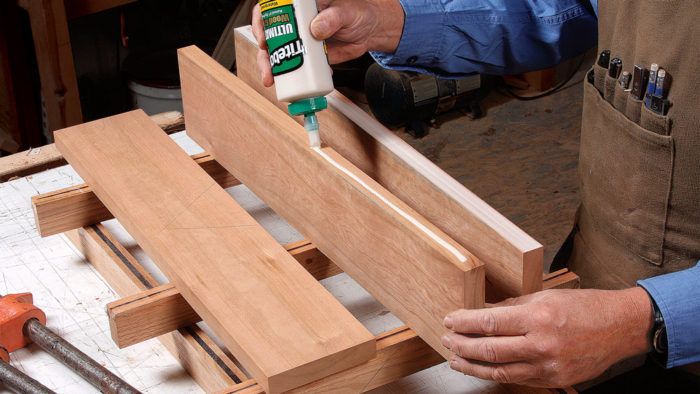Can I Glue The Registers In The Wall
How-To
Do you put glue on i surface or two?
Bob Van Dyke and Mike Pekovich answer the age erstwhile question, and disagree

Question from Matt: I see many of the globe'south best woodworkers merely utilise glue to one mating surface of a joint, not both, as advocated past Bruce Hoadley. When is it acceptable to apply gum to one surface of a mating joint?
"Double spreading, or applying adhesive to each of the mating surfaces,
is recommended where viable. This ensures total wetting of both
surfaces, without relying on pressure and flatness to transfer the
glue and wet the contrary surface. With double spreading, a greater
amount of mucilage per mucilage line is necessary, perhaps a third more."
-Bruce Hoadley–Issue #7–Summer 1977

Mike :The deviation betwixt glue on one surface versus ii surfaces for me has to do with whether information technology's a blazon of articulation that tin can exist clamped together in such a mode that you're increasing the corporeality of pressure on the mucilage surfaces. That sounds somewhat obvious, but if you lot think of a panel gum-upward, edge to edge, the more clamps you put on–or the more y'all tighten them–the more pressure you're putting on that joint.The other blazon of articulation would be like a mortise-and-tenon articulation. Yous can clamp that together, just all you're doing is keeping that shoulder seated to the opposing slice. You're non adding clamping pressure to the mortise and tenon, y'all're relying on the fit of the joint. So whenever I can't get the ii joints to come up together with a clench, like a mortise-and-tenon joint, I will glue both faces.
When I can get some clamping force per unit area on at that place, like a panel glue-up, there are 2 problems with putting gum on both edges. Y'all take a certain amount of working time with the gum before it starts to skin over and compromise the glue articulation. So showtime, if I'm gluing both surfaces, I'm going to tend to put a thinner glaze of glue on each surface, and the thinner glaze is going to take a chance to skin over a little fleck faster than a thicker coat. 2d, I'm applying gum to twice as many surfaces so it takes me twice as long to apply that glue, which leads to the same problem. If I put one heavier coat on a single face of that glue-up, I tin can do it twice equally fast, and that heavier coat is not going to skin up as fast every bit a thinner glaze. So, in a nutshell, I practice one surface on these kinds of joints because it's a lot faster, and that has its ain benefits.

Bob: What Mike said makes total sense, especially the skinning over matter. If I'm doing an edge joint on a console, I volition put a bead of mucilage down both edges, down the heart. While information technology's still a bead I have more than time, because there's non as much surface area for the air to get to. A fter all the glue beads are on, I take my finger and I apace spread out the beads and distribute the glue evenly over both surfaces. And now I don't take a lot of fourth dimension, because I take a thin layer of glue like Mike was talking about, only all I take to exercise is put the boards together. There's no more glue to employ. So that's how I handle the timing thing.
As far equally whether to put glue on one border or ii: I used to only put glue on i border, because I thought, "Yeah, you put information technology on 1 edge, yous put the two together, you squish them together, now you've got it on both edges. Aren't I smart." And then I took i autonomously once, afterward nearly four or five minutes when it hadn't set up yet. I popped information technology apart, I don't remember why, and there were all of these holidays: dry spots on the side that I hadn't applied glue to directly, where the glue didn't squish on like I had been telling students all these years that it was going to. But it didn't exercise that, and now I understand why y'all're supposed to put it on both. A thin layer on both gets you to no question virtually it, rather than leaving you wondering how many little dry spots are in there. Yous'll never know until the joint fails. Information technology probably won't fail, because a good glue joint is stronger than the wood itself, so you lot can get a little holiday hither and there's and it's probably not going to exist a big deal. Just I'd nonetheless rather be safe than distressing.
Mike: I don't question Bob's technique, and I have no arguments against it whatsoever. But I'1000 still gluing just one border–for now.
Bob: Yeah, I did it that way for years and years and years and it was just a couple of years ago, when I had that feel, that I changed my technique a fiddling bit. It's a minor detail, you know. It'due south not the deviation between make or break.
This is conversation was excerpted from Shop Talk Live episode 178.
Can I Glue The Registers In The Wall,
Source: https://www.finewoodworking.com/2019/01/30/do-you-put-glue-on-one-surface-or-two
Posted by: mullanaforeg.blogspot.com


0 Response to "Can I Glue The Registers In The Wall"
Post a Comment